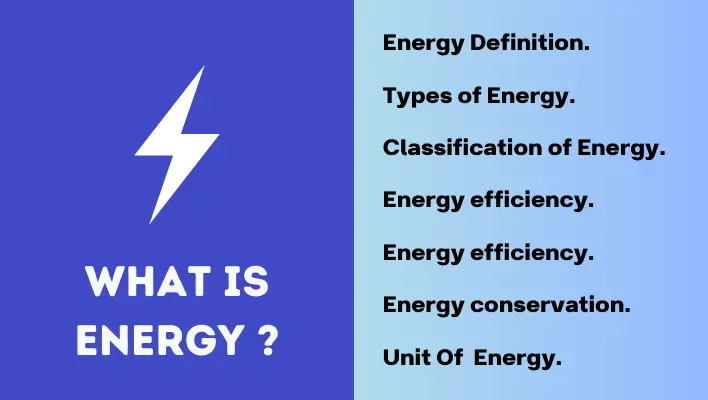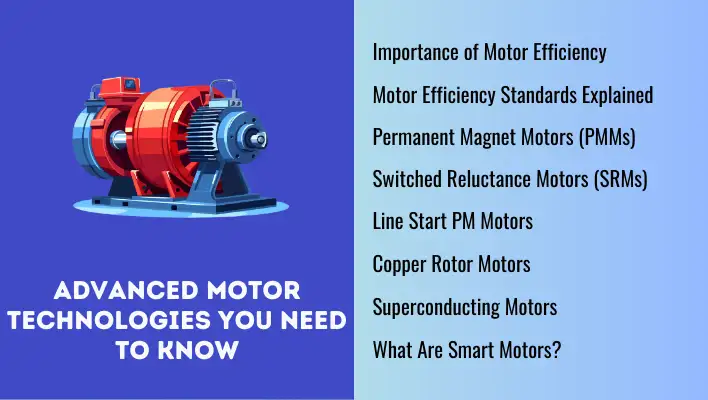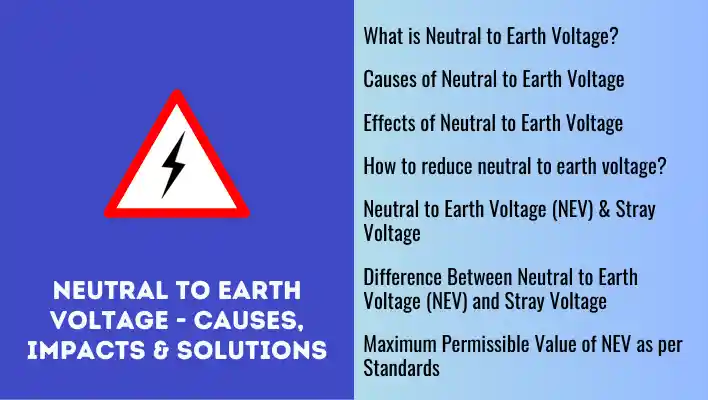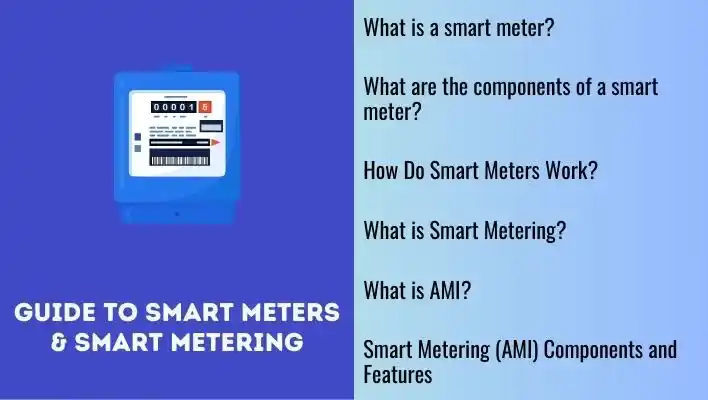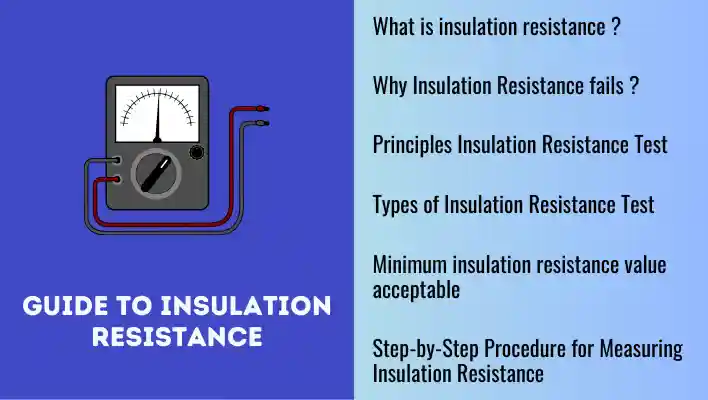Welcome! Energy is one of the most important resources we have in the world today. It powers everything from our homes, offices, transportation, communication systems and almost every machine that moves or displays data.
With the demand for energy constantly growing, it’s crucial to find ways to conserve energy and make our energy use more efficient. That’s where this blog post comes in! We’re going to explore the definition of energy, the different types and forms of energy, and where we get it from.
Plus, we’ll dive into important concepts like energy conservation, energy efficiency, and green energy, and explain why they matter so much in today’s world. So, let’s get started and explore the fascinating world of energy together!
Also Read: Renewable Energy | A comprehensive explanation
What is energy? Is it easy to define?
Energy seems simple at first, but it’s actually quite complicated to define. In fact, it’s one of those technical terms where it’s easier to explain its performance or behavior rather than what it is.
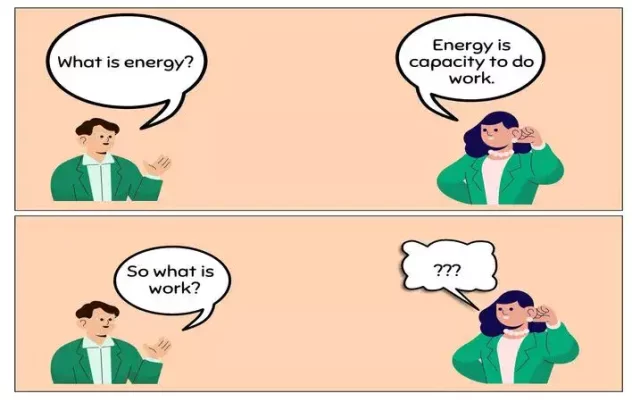
Most textbooks give a definition of energy as the ability to do work, which isn’t very helpful because it doesn’t explain what energy actually is, and assumes you already know what work means.
We get a better understanding of energy from the United Nations publication on concepts and methods in energy statistics. It states,
“Energy” means the capacity for doing work or for producing heat, energy can be regarded as “stored work”. The heat produced may be so intense as to emit light. Heat, light, motive force and chemical change induced by; or resulting in, electricity cover sufficiently for the present purpose the range of manifestation of “energy”.
The passage basically defines energy as “stored work.” This means that when an object has energy, it has the potential to do work. When the energy is released, it can turn into different forms such as heat or light.
The quote also mentions that electricity can cause chemical changes, heat, light, and motive force, which are all notable indications (manifestations) of energy. For instance, when an electrical current flows through a wire, it can create heat or light and generate a magnetic field that can produce a motive force.
Overall, the statement points out the various forms that energy can take, from heat and light to chemical changes and motive force. It highlights the crucial role that energy plays in the physical world.
So it can be concluded that energy is a complex term that lacks a specific definition. Instead, it is often observed or explained by its behavior or performance.
Also Read: Explained | Top 7 Solar Energy technologies
Types of Energy
The first law of Thermodynamics, which is commonly referred to as the law of conservation of energy. It states that,
“Energy can neither be created nor it can be destroyed. It can however be converted from one form to another or transferred from one system to another. The term system can mean anything from a simple object to a complex machine”.
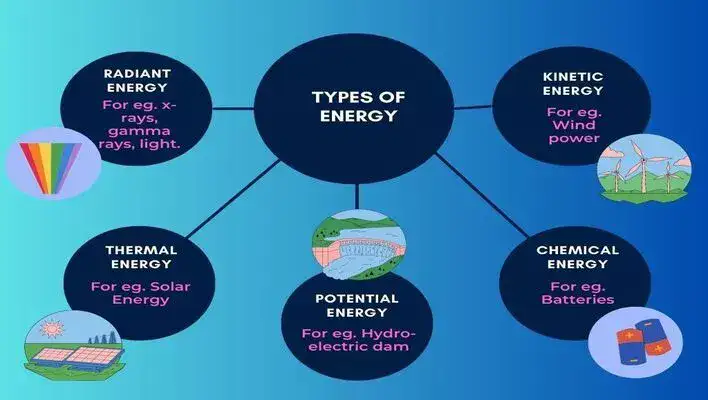
So, according to the law of energy conservation, energy can’t be created or destroyed. Instead, it can be transformed from one form to another or transferred from one system to another.
For example, when you have a ball at the top of a hill, it has potential energy. When you release the ball, it converts that potential energy into kinetic energy, which is the energy of motion.
Similarly, when you apply the brakes in your car, the mechanical energy is converted into thermal energy, which creates friction and slows the car down.
When we talk about a “system,” we’re referring to any object or collection of objects that we want to study. So, a system could be as simple as a ball rolling down a hill or as complex as a car engine or a power plant.
Understanding energy conversion and transfer is really important for technological applications. For instance, in a power plant, we convert chemical energy into heat energy, which is then used to create steam. That steam is then used to turn a turbine, which generates mechanical energy that we can convert into electrical energy.
From the law of conservation, we can understand that energy is something that cannot be touched, smelled, or seen and exists in various forms. Even though it is non-physical, it can be measured and categorized into different forms of energy such as,
- Potential Energy – an energy that a body possesses because of its position or configuration. For e.g. Water reservoir in a Hydro-electric dam.
- Kinetic Energy – the energy a body possesses by virtue of its motion & velocity. For eg. Water flowing down the dam and using its velocity to turn the turbines.
- Chemical Energy – a form of (potential) energy stored in a device which can be released by chemical reaction. For e.g. Batteries which store chemical energy to be changed into electricity.
- Thermal/Heat Energy – it is a form of energy obtained when a substance is heated up. It can also be referred to as heat energy which is produced when a rise in temperature causes atoms and molecules to move faster and collide with each other.
- Radiant Energy – is a form of electromagnetic energy which can be visible waves like light energy or invisible waves such as radio waves or x-rays.
Also Read: Wind Energy 101: Explore the Basics of a Sustainable Future
Energy classification
The forms of energy are of no use until they are utilized. Hence based on the consumption, energy is further classified in to the following,
- Primary energy
- Secondary energy.
- Non-renewable energy.
- Renewable energy
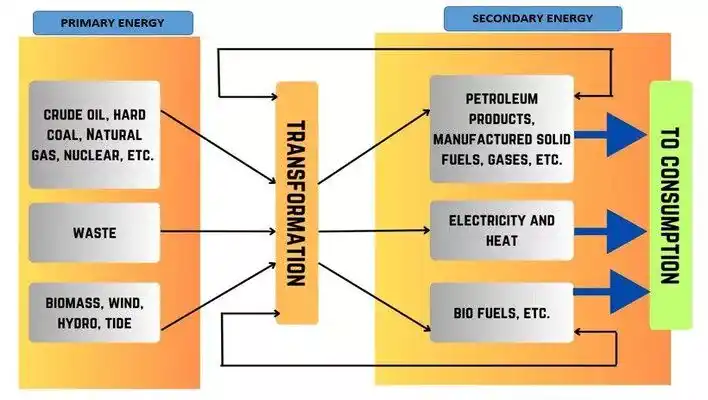
Primary Energy
The United Nations document on concepts and methods in energy statistics characterizes Primary energy as,
“Those sources that only involve extraction or capture, with or without separation from contiguous material, cleaning or grading, before the energy embodied in that source can be converted into heat or mechanical work.”
So, basically, the statement is saying that when we talk about “primary energy,” we should be talking about energy sources that come directly from nature and don’t need a lot of processing before we can use them to generate heat or mechanical work.
This includes things like fossil fuels such as coal, oil, and natural gas, as well as renewable energy sources like sunlight, wind, water, and biomass.
It’s okay if these energy sources go through basic extraction or capture processes, like drilling for oil or natural gas, or mining for coal, or capturing sunlight with solar panels.
But if they need a lot of cleaning, grading, or separation from other materials, they shouldn’t be considered “primary” anymore.
So, in a nutshell, “primary energy” should be used for energy sources that are in their natural state and don’t need much processing before they can be used for heat or mechanical work.
Secondary Energy
Secondary energy sources are basically forms of energy or fuels that come from primary sources, like fossil fuels (coal, oil, and natural gas), nuclear energy, or renewable sources such as sunlight, wind, water, and biomass.
These secondary energy sources are created through different processes that convert the primary sources into more practical and usable forms of energy.
We use these secondary sources to power our homes, industries, transportation, and other applications in our daily lives.
In summary, secondary energy sources are forms of energy or fuels that are generated or manufactured from primary sources of energy.
They play a crucial role in meeting our energy demands and providing us with the necessary power for various applications.
Let’s take a closer look at some examples of secondary energy sources:
- Electricity: This is a common secondary energy source that we get from primary sources like fossil fuels, nuclear energy, and renewable sources like sunlight, wind, and hydro-power.
- Refined petroleum products: These are secondary energy sources that are derived from crude oil, which is a primary fossil fuel. Crude oil goes through different refining processes like distillation and cracking to produce refined petroleum products such as gasoline, diesel, and jet fuel.
- Bio-fuels: These are secondary energy sources that we get from renewable sources like biomass, which includes organic matter like crops, agricultural residues, and wood. Bio-fuels, such as ethanol and biodiesel, are used as alternatives to fossil fuels in transportation and other sectors to reduce greenhouse gas emissions and our dependence on finite fossil fuel reserves.
- Hydrogen: This is a secondary energy source that can be produced from primary sources like natural gas, coal, biomass, and through electrolysis of water using electricity. Hydrogen can be used as a fuel in various applications, including transportation, electricity generation, and industrial processes.
- Synthetic fuels: These are secondary energy sources that are manufactured from primary sources like coal, natural gas, or biomass using chemical processes. Synthetic fuels, also known as synfuels, include products like synthetic gasoline, diesel, and natural gas. These fuels can be used as alternatives to conventional fossil fuels and can be used in existing combustion engines with minimal modifications.
Non-renewable energy.
Non-renewable energy sources are basically energy sources that can’t be replenished on a human timescale. They take millions of years to form, and once they’re used up, they’re gone.
These sources of energy come from ancient plants and animals that have been buried and compressed over millions of years, and they’re known as fossil fuels.
Fossil fuels such as coal, oil, and natural gas are used to generate electricity, power transportation, and provide heat in many industries and homes.
Another non-renewable energy source is uranium, which is used in nuclear power plants to produce electricity through a process called nuclear fission.
Uranium is a radioactive element that’s extracted from the earth’s crust and processed for use in nuclear reactors.
The thing is, non-renewable energy sources have some pretty negative impacts on the environment and society.
They can cause air and water pollution, destroy habitats, and emit greenhouse gases that contribute to climate change. Plus, since they’re finite, they’ll eventually run out.
That’s why there’s a growing need to transition to renewable energy sources, like solar, wind, hydro-power, geothermal, and biomass.
Renewable energy
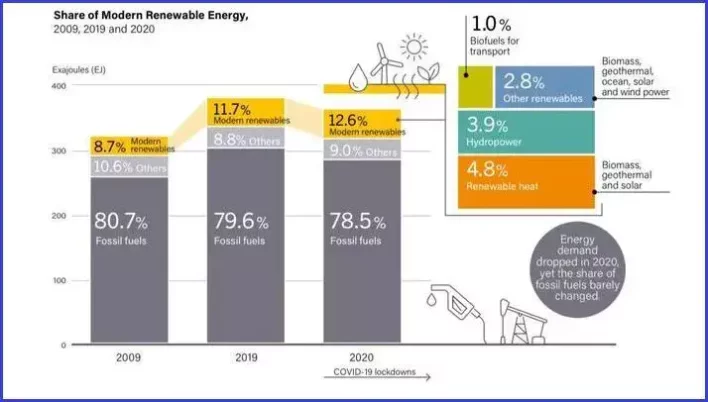
Renewable energy is all about using natural resources that keep replenishing themselves, so we never run out. And the best part is, they’re Eco-friendly!
These energy sources don’t harm the environment, don’t produce harmful emissions, and don’t mess up our ecosystems.
There are lots of advantages to using renewable energy. For one, they don’t add to air pollution or climate change like other sources do.
They’re also usually abundant and available, so we don’t have to worry about running out of them.
Plus, they can create jobs and boost our economy in the renewable energy industry.
Of course, there are some downsides too. Renewable energy can be variable, depending on things like weather and location.
Also, the initial cost in setting up renewable energy sources is high, but as the time goes by these costs will come down.
But overall, renewable energy is super important for creating a more sustainable and Eco-friendly energy system.
Here are some examples of renewable energy sources we use today:
- Solar Energy: We get this from the sun’s rays, and we can capture it using things like solar panels and solar thermal systems. Solar panels turn sunlight into electricity using special cells, and solar thermal systems use the sun’s heat to warm water or spaces.
- Wind Energy: We use wind turbines to capture the power of the wind and turn it into electricity. This works best in windy areas like coasts and open plains.
- Hydro-power: We use flowing water from rivers, dams, and ocean tides to generate electricity in hydroelectric power plants. They use the water to spin turbines and make electricity.
- Geothermal Energy: We tap into the heat inside the Earth’s crust to generate geothermal energy. We can use hot water or steam from underground to make electricity in geothermal power plants.
- Biomass Energy: We use organic matter like wood, crop leftovers, and animal waste to make biomass energy. We can use it for things like heating, electricity, and bio-fuel.
Also Read: Guide to Geothermal Energy | How Earth’s Power is Harnessed?
Energy Efficiency
Energy efficiency is one of our most overlooked energy solutions.
It is achieved when the energy intensity in a specific product, procedure or area of production or consumption is reduced without affecting the output, consumption or comfort levels.
In simple words, energy efficiency means using less energy to perform the same function.
It is generally expressed as a ratio of useful work or energy output to its corresponding energy input. The less energy a system requires to produce a desired output the more energy efficient that system is.
[latex]Energy Efficiency = \frac{Output}{Input}[/latex]
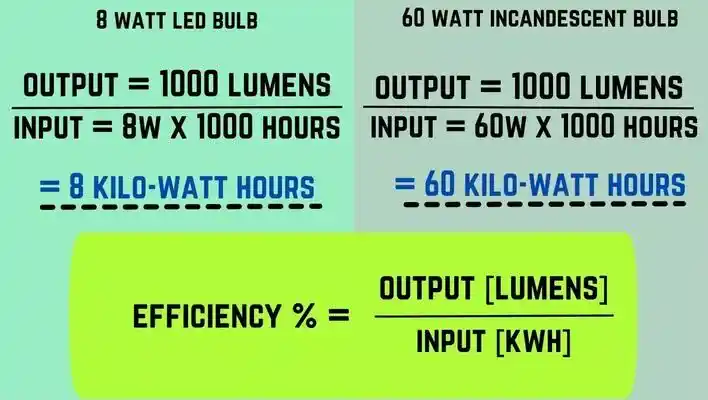
For example, let’s compare a 8 watt LED bulb to a 60 watt incandescent light bulb. Both can produce the same amount of light measured in lumens.
If we use both bulbs for 1000 hours the LED bulb will have used 8 kilowatt hours of energy whereas the incandescent bulb will have used 60 kilowatt hours of energy.
Most electricity bills are charged per kilowatt hour so over time these energy savings across appliances will result in cost savings too.
We can apply the same output divided by input formula to compare other things too. The efficiency of two different modes of transportation like between Bus & Car, heating and cooling systems or water use efficiency of two food products.
Energy efficiency applies to more than light bulbs. For instance houses where less air escapes take less energy to heat and cool.
Another case would be of cars that run with electric motors and powered by batteries waste less heat so they can go further on fewer joules of energy. However the overall efficiency and overall greenhouse gas emissions would also depend on how the electricity is produced.
Energy efficiency is like the superhero of clean energy transitions, often called the “first fuel”.
It’s a super fast and cost-effective way for tackling CO2 emissions, lowering energy bills, and making our energy sources more secure.
In fact, it’s the top measure to cut down on energy demand in order to achieve the Net Zero Emissions by 2050 goal.
Along with the well regulated measures of electrification, behavioral change, digitization and material efficiency, energy efficiency is the single largest measure to avoid energy demand in the Net Zero Emissions by 2050 Scenario.
Also Read: 8 Latest Trends in Electrical Engineering
Is energy efficiency the same thing as energy conservation?
Energy conservation and energy efficiency are two different but related concepts.
Energy conservation is about reducing overall energy consumption, while energy efficiency is about using energy more effectively. Both concepts are related because improving energy efficiency can lead to energy conservation.
Let me explain.
When we talk about energy conservation, we’re talking about reducing overall energy consumption. This can be done through technological advancements, but also by making changes to our lifestyles and behaviors, thereby reducing energy losses.
On the other hand, energy efficiency is all about using energy more effectively which ultimately leads to energy conservation.
For example, mass transportation systems like buses and trains are usually more energy-efficient than even electric cars because they use significantly less energy per person per kilometer traveled.
Improving energy efficiency in buildings, transportation, shipping, and other energy-intensive processes is one of the most important ways we can combat climate change and reduce greenhouse gas emissions.
Unfortunately, global improvements in energy efficiency have been declining lately. That’s why countries all around the world should invest in energy efficiency across different sectors and advocate for climate policies that prioritize energy efficiency. This will not only help reduce emissions but also create millions of sustainable energy jobs in the process.
Energy Intensity
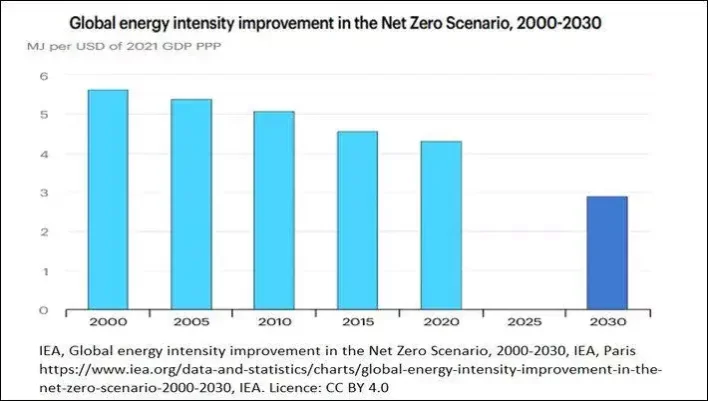
Energy is super important for a country’s economy as it’s used in various sectors like transportation, manufacturing, agriculture, and homes. But, how we produce and use energy can have good or bad effects on the environment.
Energy intensity measures the amount of energy required to produce a unit of economic output and also provides insights into the relationship between energy consumption and economic development.
A high energy intensity indicates that a country or industry is using more energy to produce a unit of output, which may be inefficient and result in higher energy consumption and associated environmental impacts.
On the other hand, if energy intensity is low, it means less energy is used to produce the same output, which is better for the environment and shows higher energy efficiency.
Energy intensity also helps us understand the environmental impact of energy use during economic growth.
When countries develop economically, they usually use more energy, which can cause more greenhouse gas emissions, air pollution, and other environmental issues.
By keeping an eye on energy intensity, policymakers and industry leaders can see if their energy efficiency efforts are working to reduce the environmental impact of energy use during economic growth.
Energy intensity promotes energy efficiency, which can save money for businesses and homes and reduce dependence on energy imports.
Second, it can help lessen the negative environmental impacts of energy production and use, like lowering greenhouse gas emissions and air pollution.
Third, it can make energy sources more diverse and reduce vulnerability to price changes and supply disruptions, which is good for energy security.
Lastly, it can support economic growth by using energy resources more wisely and encouraging innovation in energy-efficient technologies, which can create jobs and boost the economy.
In a nutshell, energy intensity is a crucial measure that shows the relationship between energy use and economic development, and helps us understand the environmental impacts of energy production and use.
Kilo-watt Hour (KWH) or Joule (J). What is the unit of energy ?
The Joule is a unit of energy commonly used in physics, and it is equal to the work done when a force of one newton is applied over a distance of one meter.
While the Joule is a useful unit for measuring small amounts of energy, it is often too small to be practical for measuring the energy used by appliances, homes, and businesses.
The Kilowatt-hour, on the other hand, is a much larger unit of energy and is better suited to practical energy measurement.
It is defined as the amount of energy used when one Kilowatt (1000 Watts) of power has been used for a time of one hour (3600 seconds).
For example, if a 100-watt light bulb is turned on for 10 hours, it would consume 1 kilowatt-hour of electricity (100 watts x 10 hours = 1,000 watt-hours or 1 kilowatt-hour).
Similarly, if a household consumes 500 kilowatt-hours of electricity in a month, it means they have used an average of around 16.7 kilowatt-hours per day.
The Kilowatt-hour is a widely used unit for measuring energy consumption, and it is used by electricity providers to bill their customers based on the amount of electricity they consume.
It is also used to describe the energy storage capacity of batteries and other energy.
Summary
- Energy is a complex term that is often explained by its behavior or performance rather than having a specific definition.
- The United Nations publication on concepts and methods in energy statistics defines energy as the capacity for doing work or producing heat, and it can be regarded as “stored work”.
- Basic extraction or capture processes are acceptable for primary energy sources, but excessive cleaning, grading, or separation from other materials disqualify them as primary energy.
- Secondary energy sources are forms of energy or fuels that are derived from primary sources through various processes to make them more practical and usable.
- Energy efficiency involves reducing the energy intensity in a specific product, procedure, or area of production/consumption without affecting output or comfort levels.
- Energy efficiency is a crucial tool in achieving clean energy transitions, lowering energy bills, reducing CO2 emissions, and securing energy sources, and is a key measure in achieving the goal of Net Zero Emissions by 2050.
- Energy conservation and energy efficiency are related concepts but are different. Energy conservation focuses on reducing overall energy consumption, while energy efficiency is about using energy more effectively.
- High energy intensity indicates inefficiency, leading to higher energy consumption and environmental impacts, while low energy intensity signifies higher energy efficiency and better environmental performance.

